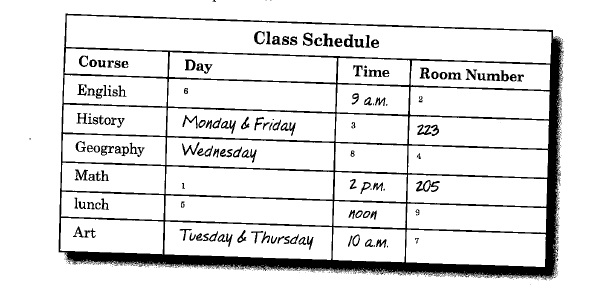
(This posting includes a handout which you are welcome to use with your students.)*
At first, this pair-work activity looks like it’s about getting students to talk a lot by filling information in a chart. But that’s not the most important value of it.
Yes, students will talk a lot during this. But by including a short pre-exercise, they will see how they should ask clarification questions when they need more information or if they didn’t understand. Asking clarification questions is the strategy that they can use in future conversation situations in and outside the classroom.
In this activity, the students will be filling in information about a class schedule. They’ll need to listen to their partners tell them the name of courses, days, times and room numbers. They’ll have many chances to ask questions, especially if they don’t understand.
There are three steps in this activity:
- Step 1: Brief work with a model showing how to do Step 2.
- Step 2: Pair activity (Student A/ Student B)
- Step 3: Exercise to do if they finish before other pairs have finished.
See attached handout BCS Info Gap Handout
Step 1 (Exercises 11 & 12 in the handout ). This is a brief model for how to carry out Step 2, in which they will only see their part (either Students A or Student B). As they complete these two exercises, they will see how two students interacted with each other to fill in the missing information. After they do these, they will know exactly how to do the pair work.
Step 2 (Exercise 13 in the handout). Students are assigned a partner. One is given the handout for Student A and the other is given Student B. Student A begins by finding the #1 blank space on his/her chart and asking B (who has that space filled in on his/her chart) a question about that blank space. For example, “What day is Math class?” Needless to say, Student A needs to be able to formulate the question and Student B needs to listen carefully to find the answer. If either of them don’t do this quite clearly, they use clarification questions.
After Student A has filled in all the blank spaces on his/her chart, Student B asks questions to fill in his/hers.
Step 3: Some pairs will finish sooner than the other. Instead of stopping everyone at that point, it’s best to have something ready for these early finishers. Here are three option:
- Option 1) They can trade parts (A becomes B and vice versa) and do the activity again. I have found the majority of students like to do this.
- Option 2) They can talk about any topic that they want in English.
- Option 3) Ask each other the discussion questions included.
For another example/handout of an information gap activity, see Conversation Activity: Stimulating Students to Listen and Respond to Each Other
For many more gap exercises at this level, see Pro Lingua Learning Basic Conversation Strategies
For more activities for responding to partners, see Conversation magic: Two most important conversation techniques (Part 1) and
For more about conversation activities that engage students, see Conversation class: Necessary ingredients for successful pair work (from research)
David Kehe
*About the free-download materials. During my 40 years of teaching ESL, I have had many colleagues who were very generous with their time, advice and materials. These downloads are my way of paying it forward.